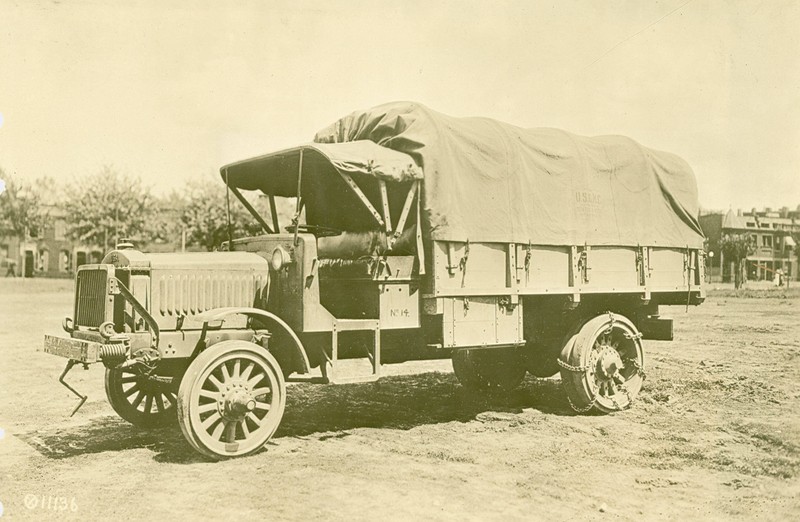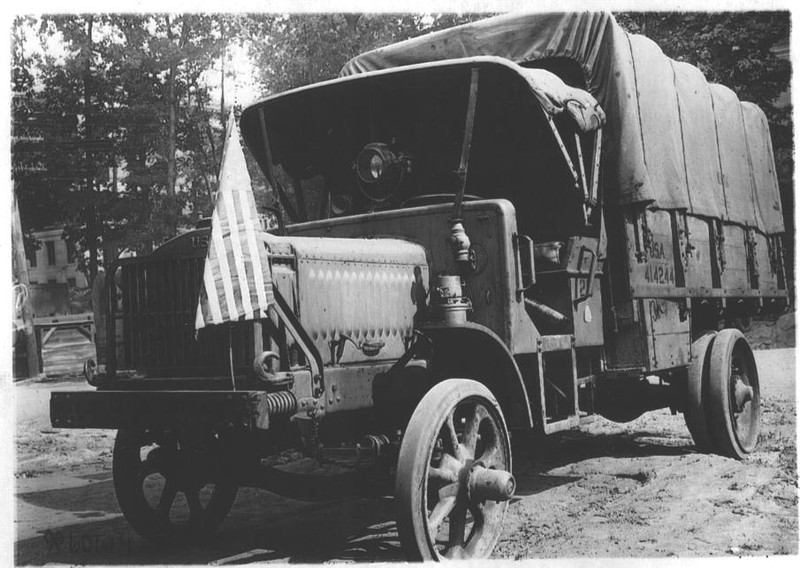The Gramm-Bernstein Motor Truck Company (1910-1930)
Introduction
Text-to-speech Audio
Images
Gramm-Bernstein Military Trucks at the Company in Lima; these were manufactured for the government before the Gramm-Bernstein Company received the contract to produce the Class B "Liberty" Trucks

A first series "Liberty" Truck manufactured in early 1918

A second series "Liberty" Truck

A Gramm-Bernstein-manufactured "Liberty" truck on display at the National Museum of the US Air Force

Backstory and Context
Text-to-speech Audio
Benjamin A. Gramm was involved in the automobile industry since at least 1902 and founded The Gramm Motor Car Company in Lima in 1910. The company manufactured one-, two-, three-, and five-ton trucks. In 1911, a new factory was designed for the company by the Lima architectural firm of McLaughlin & Hulskin. Gramm advertised this structure as, “the largest motor truck factory in the world.”[4] By 1912, the company was known as The Gramm Motor Truck Company, and its office was located at 110 South Lima Street in Lima. The company was reorganized later that year with John N. Willys as the new President and General Manager and sales were placed under his Willys-Overland Company of Toledo (the company that would later develop the famous Jeep). Shortly thereafter, Willys was elected Vice President of the Hexter Motor Truck Company, which managed the sale of Gramm trucks in New York City. Among other models, The Gramm Motor Truck Company manufactured an innovative power winch dump truck. They advertised that, “Gramm transportation plans and truck equipment have done more toward economically reorganizing transportation problems than any other means yet introduced.”[4]
Around July 1912, Benjamin A. Gramm and Max Bernstein established The Gramm-Bernstein Company, which had $500,000 in capital stock and intended to begin marketing its two- and three-and-a-half-ton trucks that October. Their new plant was almost finished by the end of July. It was one story tall (with high ceilings), fifty to sixty-three feet wide, and 316 feet long, with a 125-foot stack. The factory was also located along the Pennsylvania Railroad and Detroit, Toledo & Ironton Railroad tracks. The Power Wagon magazine wished Gramm success on his new venture and his new line of high-quality trucks, calling him, “one of the early and successful pioneers in the power wagon industry in America.”[4] (Gramm also had many patents, and the Sacramento Union went so far as to call him, “the father of the motor truck industry.”[7]) Both The Gramm Motor Truck Company and The Gramm-Bernstein Company were still in operation as of February 1913, when they exhibited at the Chicago Automobile Show; however, the former would stop production later that year.
The Gramm-Bernstein Company ran a brisk domestic and international business. In early 1916, it received a $1,225,000 order for commercial trucks from Great Britain. Later that spring, its northwest distributor, Beaumont & Williams, established a Seattle office, and its eastern branch, The Gramm Worm-Drive Motor Truck Company, leased an office in New York City to sell its one- to six-ton trucks. In the fall of 1916, The Gramm-Bernstein Company reorganized, and Gramm and Bernstein incorporated The Gramm-Bernstein Motor Truck Company, with four million dollars in capital stock.
In 1917, The Gramm-Bernstein Motor Truck Company began producing trucks for the US Army in the First World War. At the time, the military was using 294 different makes and models of truck, including some from the Gramm-Bernstein company. However, this variety presented a huge logistical issue; while trucks performed better than horses, maintaining this many different models proved a challenge for the crews assigned to maintain and repair the trucks. This problem led the Quartermaster Corps to form a committee to design a standardized military truck. The committee included Quartermaster officers, Society of Automotive Engineers members, and corporate volunteers, including from Gramm-Bernstein. Their final design, approved in the summer of 1917, was officially the Class-B Standardized Military Truck, but is much more well known as the “Liberty Truck.” In addition to easy maintenance, the truck was designed to be powerful, quiet, rugged, and easy to steer. The Army newspaper, Stars and Stripes, declared, “it has all the attachments except those for golf clubs and lunch hampers.”[10] This standardized truck was the predecessor for later mass production efforts, such as the Jeep and Liberty Ship. It also sped the Army’s transition from reliance on horses and trains to gasoline-powered vehicles for transportation.
The first Liberty Truck, using parts from fifty other companies, was completed at the Gramm-Bernstein factory on October 7th, 1917. Three days later, thousands gathered in Lima to wish the truck farewell and send it off on its maiden voyage to Washington, D.C. Here it underwent extensive trials by the War Department; a Gramm-Bernstein Liberty Truck, probably this first model, was also inspected by President Wilson himself at the White House. Nearly 9,500 Liberty Trucks were produced by the end of the war by fifteen different companies, including one thousand by Gramm-Bernstein. In 1918, the company was recognized for, “loyalty[,] energy[,] and efficiency in performance of the war work.”[11]
In the years following the war, Gramm-Bernstein trucks were sometimes known as Gramm-Pioneers. The company continued to advertise their trucks’ high quality, sturdiness and strength, and resilience and durability, as well as Gramm’s experience in the industry. In 1919, they offered a one-and-a-half-, two-, two-and-a-half-, three-and-a-half, and five-ton truck. From 1925-26, Gramm, his son W.J. Gramm, and R.M. Kincaid operated Gramm and Kincaid Motor Inc., which manufactured one- to four-ton trucks, moving vans, fire trucks, and buses. The Gramm-Bernstein Motor Truck Company went out of business by around 1930, and its buildings (located on what is now called Neon Avenue) were eventually purchased by Neon Products, Inc.
Sources
1) 1919 Ad Gramm Bernstein Motor Truck Liberty Lima Ohio - ORIGINAL SEP4, Period Paper. Accessed July 26th 2020. https://www.periodpaper.com/products/1919-ad-gramm-bernstein-motor-truck-liberty-lima-ohio-original-advertising-059718-sep4-668.
2) Beecroft, David, ed. The Automobile. Volume 34 (January 1st-July 1st 1916). New York City, NY. The Class Journal Company, 1916. pp. 76, 78-79, 84, 508, 525, 705, 748, 836. Google Books (original from the University of Michigan). February 12th 2007. Accessed July 26th 2020. https://books.google.com/books?id=0sgqAAAAMAAJ.
3) Beutner, Jeff. Gramm-Bernstein Delivery Truck, c. 1916, Urban Milwaukee. May 17th 2016. Accessed July 26th 2020. https://urbanmilwaukee.com/2016/05/17/yesterdays-milwaukee-gramm-bernstein-delivery-truck-c-1916/.
4) Farrington, Henry, ed. The Power Wagon: Issues 92-97. Chicago, IL. The Power Wagon Publishing Company, 1912. pp. 19, 22, 55, 56, 64, 68, 72, 81, 117, 125, 129. Google Books (original from the University of Michigan). October 23rd 2009. Accessed July 26th 2020. https://books.google.com/books?id=I2HmAAAAMAAJ.
5) First Class B Liberty truck photograph; World War I in Ohio Collection, Ohio History Connection. Accessed July 26th 2020. https://ohiomemory.org/digital/collection/p16007coll51/id/761/.
6) Gastelu, Gary. The World War 1 Liberty Truck put the U.S. Military on wheels, FOX News. November 11th 2018. Accessed July 26th 2020. https://www.foxnews.com/auto/the-world-war-1-liberty-truck-put-the-u-s-military-on-wheels.
7) "Gramm-Bernstein, Pioneer Truck Makers, Reorganize." Sacramento Union (Sacramento, CA) October 8th 1916. vol. 191. no. 38. p. 23. UCR: Center for Bibliographical Studies and Research: California Digital Newspaper Collection. Accessed July 26th 2020. https://cdnc.ucr.edu/?a=d&d=SU19161008.2.175&e=-------en--20--1--txt-txIN--------1.
8) Hoersten, Greg. Samuel ‘Mr. Sign’ Kamin, LimaOhio.com. May 21st 2019. Accessed July 26th 2020. https://www.limaohio.com/features/lifestyle/356931/samuel-mr-sign-kamin.
9) Holdgreve, Robert. Window to the Past: Early trucks, buses and campers: Lima, originally published in the Delphos Herald, on the website Delphos, Ohio History. June 19th 1999. Accessed July 26th 2020. http://www.delphos-ohio.com/Holdgreve/trucks_buses_campers.htm.
10) "Liberty Truck, America's Best, Reaches France." The Stars and Stripes (Paris, France) October 4th 1918. vol. 1. no. 35. p. 8. Library of Congress. Accessed July 26th 2020. https://www.loc.gov/resource/20001931/1918-10-04/ed-1/?sp=8.
11) The "Liberty Truck" in Lima: The Gramm-Bernstein Motor Truck Company, BGSU: University Libraries: Digital Gallery. Accessed July 26th 2020. https://digitalgallery.bgsu.edu/exhibits/show/northwest_ohio_in_wwi/homefront/gramm_bernstein.
12) The Liberty Truck, U.S. Army Transportation Museum. Internet Archive Wayback Machine. October 17th 2004. Accessed July 26th 2020. https://web.archive.org/web/20041017211748/http://www.transchool.eustis.army.mil/Museum/LIBTrucks.htm.
13) Lloyd, W.S., ed. The Ohio Architect, Engineer and Builder. Volume 18. Cleveland, Ohio. The Ohio Architect, Engineer and Builder Company, 1911. pp. 40-41. Google Books (original from the New York Public Library). June 18th 2008. Accessed July 26th 2020. https://books.google.com/books?id=4HQoAAAAYAAJ.
14) Motor Vehicles - Motor Trucks - Types - Manufacturers - Liberty First (See also Bethlehem) - Fleet of Gramm-Bernstein military trucks furnished the Government, before they were awarded contracts for building the Class "B" Truck. The Gramm-Bernstein Motor Truck Co., Lima, Ohio, National Archives Catalog. Accessed July 26th 2020. https://catalog.archives.gov/id/45507624.
15) Mroz, Albert. American Military Vehicles of World War I: An Illustrated History of Armored Cars, Staff Cars, Motorcycles, Ambulances, Trucks, Tractors and Tanks. McFarland, 2009. pp. 162, 234. Google Books. https://books.google.com/books?id=MAA1QtNuRQEC.
16) R. L. Polk & Co.'s Lima City Directory 1918. Volume 18. Columbus, OH. R. L. Polk & Co., Publishers, 1918. p. 302. Ancestry.com. U.S. City Directories, 1822-1995 [database on-line]. Provo, UT, USA: Ancestry.com Operations, Inc., 2011. Accessed July 26th 2020. https://www.ancestry.com/imageviewer/collections/2469/images/4091898.
17) WWI Standard B "Liberty" Truck, National Museum of the US Air Force. Internet Archive Wayback Machine. July 29th 2010. Accessed July 26th 2020. https://web.archive.org/web/20100729221542/http://www.nationalmuseum.af.mil/factsheets/factsheet.asp?id=8126.
National Archives (https://catalog.archives.gov/id/45507624)
By US Signal Corps on Wikimedia Commons (https://commons.wikimedia.org/wiki/File:1st-Series_Standardized_Liberty_truck.jpg) - Public Doman
By US Signal Corps on Wikimedia Commons (https://commons.wikimedia.org/wiki/File:Second-Series_Liberty_Truck.jpg) - Public Domain
Wikipedia (https://en.wikipedia.org/wiki/File:WWI_Standard_B_%27Liberty%27_Truck_on_display_in_the_Presidential_Gallery_at_the_National_Museum_of_the_United_States_Air_Force.jpg) - Public Domain
